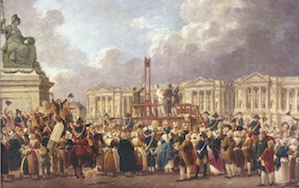...............................................................
THE FRENCH ARISTOCRACY was removed from the seats of power head-by-head. That was more than 200 years ago but in the country’s wine capital of Bordeaux there remains a full-bodied ruling class.
The region’s wine classifications are a class system bordering on cast system. They separate the low-born from the high-born and maintain order; largely neglecting modern day progression and regression.
Of course, Robert Parker et al have brought a degree of meritocracy to proceedings and helped to align Bordeaux winemakers with consumer tastes. But it is mainly the wines of Bordeaux’s upper-middle and elite classes that have access to this democracy. The untitled under-classes, who make up the majority of volume, remain mostly under-served by the systems around them – save one notable exception: their association with brand Bordeaux, which, conversely, would not be what it is without the tradition and mystique of the classification system.
So has anything changed in Bordeaux? Or more to the point, can anything change? Certainly there is no revolution. But among the middle-order – which Richard Bampfield MW describes as the “soul of Bordeaux”, a sort of faint and disparate uprising is discernible. Here, standards have steadily improved in recent years and are now closer to befitting Bordeaux’s lofty prices. In particular, there has been recognition for quality-driven Petit Châteaux (small unclassified properties), Cru Bourgeois (quality reds from Médoc) and some emerging Bordeaux brands – more on this later. By general agreement there are three distinct classes – the Grand Crus Classé (plus the likes of super-brand Petrus), the mid-market wines described above (priced around £8-£20), and the volume products at under £8. Let’s start at the top and work down.
The upper classes
In 2012 Bordeaux’s largest markets by value were the UK (€420m), Hong Kong (€242m) and China (€338m). The UK is known to re-sell its stock in Asia and Hong Kong is a gateway market for China. In short, China is the likely end destination for Bordeaux’s most expensive wines. Olivier Bernard, president of the Union of Grand Cru has watched the market grow: “China, as a new market is characterised by consumption of the most expensive and the least expensive wines – with nothing in the middle.” Apart from a few châteaux in the right-bank appellation Pomerol, the Chinese are interested in the Cru Classé. Bampfield picks up the point: “Robert Parker has given the market another reference but the classification still matters in the new markets – there is a lot of respect for Grand Crus there.”
Philippe Magrez son of Bernard Margrez, who owns four Cru Classé (Château La Tour Carnet, Château Fombrauge, Pape Clément and Château Romer) agrees: “Without the 1855 classification we don’t have Bordeaux. In China they do not love Cabernet Sauvignon – they actually prefer
Merlot – but they want Grand Cru Classé from Médoc.”




